Learning Outcomes
- To define the basics of client-server communication.
Client-Server
- Client-Server programs consist of software processes that interact via messages.
- Each process is connected via program constructs (sockets) to an input/output interface in a computer called a “port”.
- A port is a memory location shared with network software (actually more complex than this).
- Software on the other side of the port makes sure that the message you send gets there (TCP/IP).
- Java package
java.netis the Java version of the socket API.
Sockets
There are four possible operations that a socket can perform:
- Connect to a remote machine.
- Send data.
- Receive data.
- Close the connection.
A socket may not be connected to more than a host at a time.
A socket may not reconnect after it is closed (you have to start again).
Connecting
-
You must at least specify the remote host and port to connect to.
-
The host may be specified as either a string, like
xxx.brunel.ac.ukor as an InetAddress object. -
The port should be an int between 1 and 65535.
-
You cannot just connect to any port on any host, the remote host must actually be listening for connections on that port.
-
You can use the constructors to determine which ports on a host are listening for connections.
-
Sending and receiving operations are implemented via the socket interface (connected to a port).
- Sending is usually asynchronous.
- Receiving is usually synchronous.


Protocols
- Client and server.
- Tend to send, receive, send, receive, etc.
- Special instructions using Socket API.
- Can however just send, send, send but the server needs to receive, receive, receive.
Servers
- Sockets connect clients and servers.
- Servers wait for a client to connect to it.
- A server uses a Server Socket.
- A server socket binds to a particular port on the local machine and waits (listens).
- When a server detects a connection attempt, it accepts the connection.
- This allows the client and server to communicate.
Multiple Clients
- Several clients can connect to the same port on the server at the same time.
- Incoming data is distinguished by the port to which it is addressed and the client host and port from which it came.
- Incoming connections are stored in a queue until the server can accept them.
- Once the queue fills up, further incoming connections are refused until space in the queue opens up.
Internet Services Approach
- Each service has a port number that if you connect to (via a socket) you access the service.
- Most are text based.
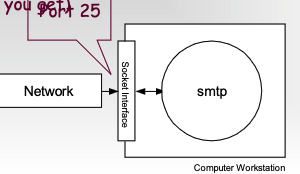
HTTP Request Message

HTTP Reply Message

Sockets and Ports

Other Network Services and Protocols
- Two types:
- Connectionless (UDP)
- Connection-oriented (TCP)
- echo 7/tcp
- echo 7/udp
- ftp 21/tcp
- telnet 23/tcp
- smtp 25/tcp
- whois 43/tcp
- finger 79/tcp
- http 80/tcp
Processes
They communicate with other processes via sockets connected to ports onto the internetworking layers and then onto a network.
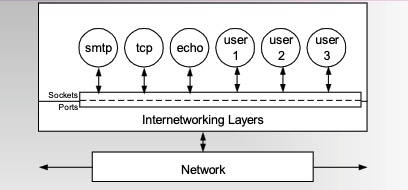
Berkley Socket API
socket():- creates a new socket of a certain socket type, identified by an integer number, and allocates system resources to it.
bind():- is typically used on the server side, and associates a socket with a socket address structure, i.e. a specified local port number and IP address.
listen():- is used on the server side, and causes a bound TCP socket to enter listening state.
connect():- is used on the client side, and assigns a free local port number to a socket. In case of a TCP socket, it causes an attempt to establish a new TCP connection.
accept():- is used on the server side. It accepts a received incoming attempt to create a new TCP connection from the remote client, and creates a new socket associated with the socket address pair of this connection.
send()andrecv(), orwrite()andread(), orsendto()andrecvfrom():- are used for sending and receiving data to/from a remote socket.
close():- causes the system to release resources allocated to a socket. In case of TCP, the connection is terminated.
gethostbyname()andgethostbyaddr():- are used to resolve host names and addresses. IPv4 only.
select():- is used to pend, waiting for one or more of a provided list of sockets to be ready to read, ready to write, or that have errors.
poll():- is used to check on the state of a socket in a set of sockets. The set can be tested to see if any socket can be written to, read from or if an error occurred.
getsockopt():- is used to retrieve the current value of a particular socket option for the specified socket.
setsockopt():- is used to set a particular socket option for the specified socket.
A “Client” Program
- It is a template that you can use to connect to any server on any machine.
- Need to be aware of the socket number and the machine address or name.
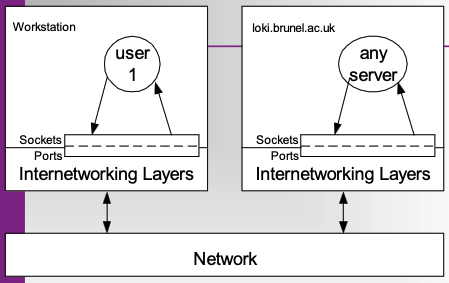
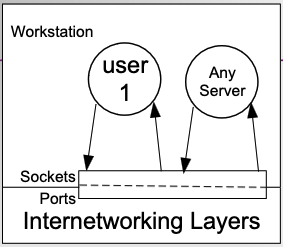
EchoServer Network Application
Simple client-server program that sends and receives (echos) from client to the server.
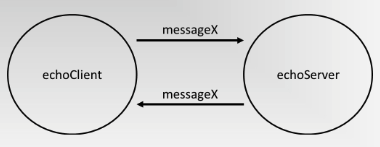
//echoserver
WHILE NOT TERMINATED
RECEIVE messageX from echoClient
SEND messageX to echoClient
ENDWHILE//echoclient
WHILE NOT TERMINATED
READ messageX FROM user
SEND messageX TO echoServer
RECEIVE messageX FROM echoServer
PRINT messageX
ENDWHILESingle Client Knock, Knock
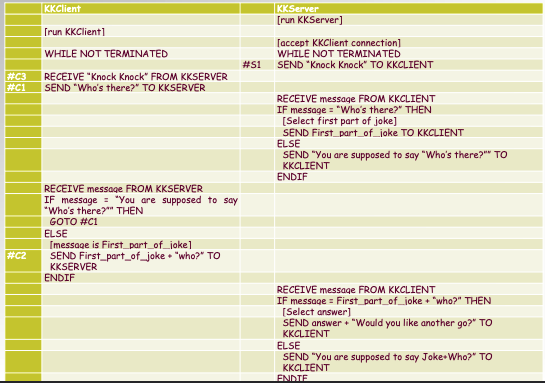
// KKClient
WHILE NOT TERMINATED
#C3 RECEIVE “Knock Knock” FROM KKSERVER
#C1 SEND “Who’s there?” TO KKSERVER
RECEIVE message FROM KKSERVER
IF message = “You are supposed to say “Who’s there?”” THEN
GOTO #C1
ELSE
[message is First_part_of_joke]
#C2 SEND First_part_of_joke + “who?” TO KKSERVER
ENDIF
RECEIVE message FROM KKSERVER
IF message = “You are supposed to say Joke+“Who?” THEN
GOTO #C2
ELSE
[message is answer + “Would you like another go?”]
IF YES THEN
SEND “y” TO KKSERVER
GOTO #C3
ELSE
SEND “n” to KKSERVER
ENDIF
ENDIF
[Terminate]
ENDWHILE// KKServer
[accept KKClient connection]
WHILE NOT TERMINATED
#S1 SEND “Knock Knock” TO KKCLIENT
RECEIVE message FROM KKCLIENT
IF message = “Who’s there?” THEN
[Select first part of joke]
SEND First_part_of_joke TO KKCLIENT
ELSE
SEND “You are supposed to say “Who’s there?”” TO KKCLIENT
ENDIF
RECEIVE message FROM KKCLIENT
IF message = First_part_of_joke + “who?” THEN
[Select answer]
SEND answer + “Would you like another go?” TO KKCLIENT
ELSE
SEND “You are supposed to say Joke+Who?” TO KKCLIENT
ENDIF
RECEIVE message FROM KKCLIENT
IF message = “y” THEN
GOTO #S1
ENDIF
[message is “n”]
[Terminate]
ENDWHILEMulti-Client Knock, Knock
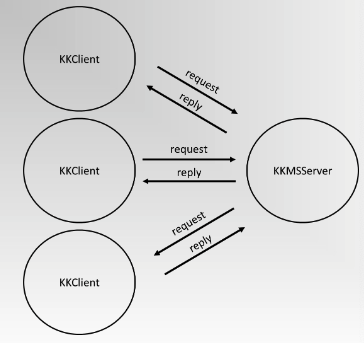
kkmserver
create a serversocket object and connect it to port 4444
while not terminated
wait for a client to connect
make the connection and start a new thread of execution using kkmsthread
endwhile
kkmsthread
begin
perform the same tasks as the original kkserver
end
Different Systems
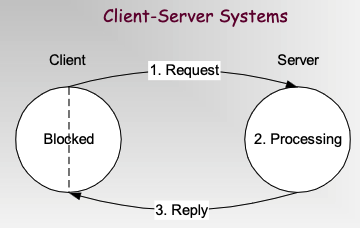
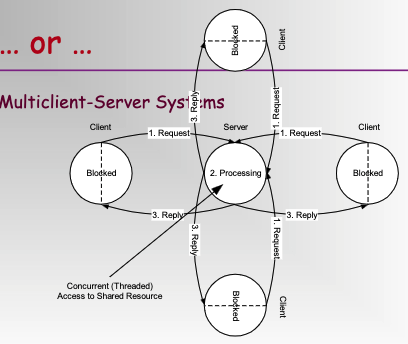
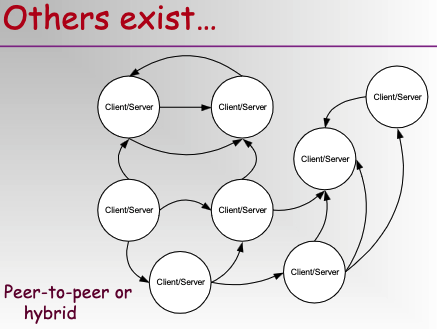
Message Passing Protocols
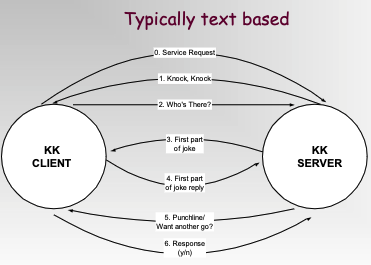
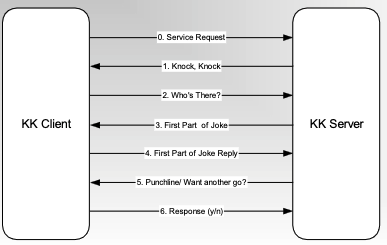
We can represent in a table:
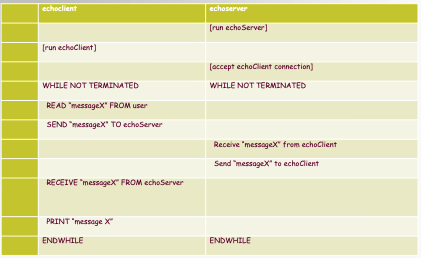
What really happens
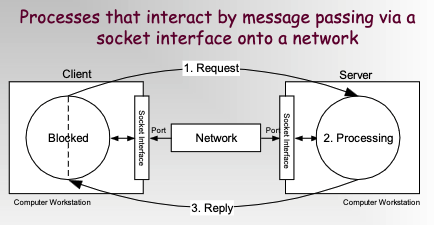
Example
Text based protocol that asks someone for 50p:


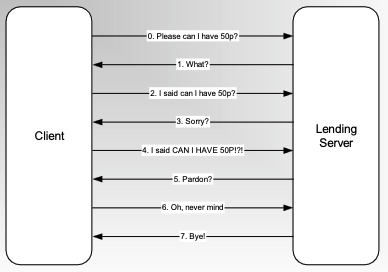
Simultaneously:

Reading
This is very general and lots of support material can be found on the web – basically you are looking for socket programming in Java.
- Try:
- download.oracle.com/javase/tutorial/networking/sockets/index.html
- www.cafeaulait.org/slides/sd2003west/sockets/Java_Socket_Programming.html
- http://en.wikipedia.org/wiki/Berkeley_sockets